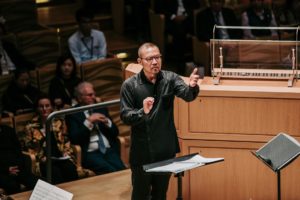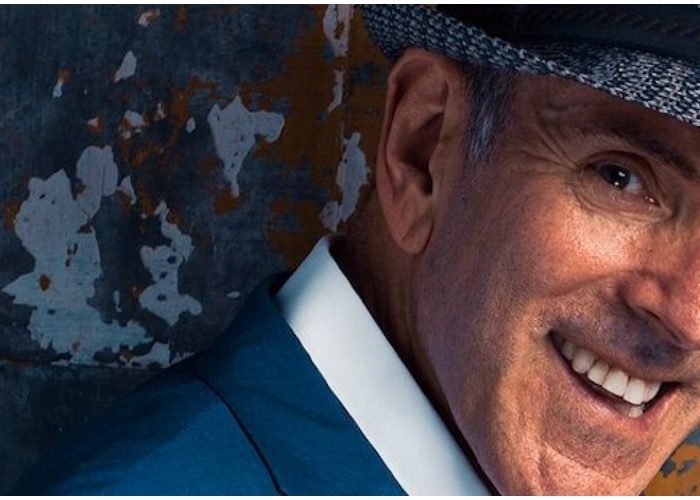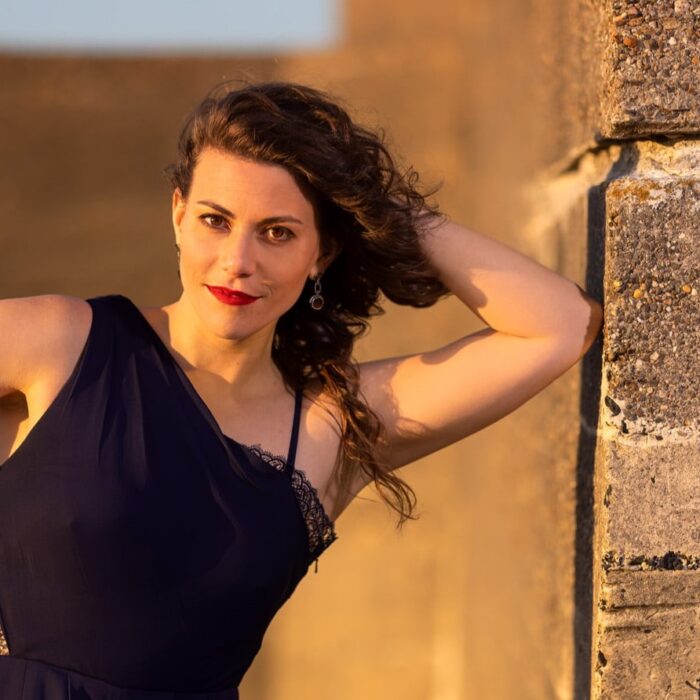
Q & A: General & Artistic Director Chien Wen-pin on Live Performances of ‘La Traviata’ & Plans for the National Kaohsiung Center for the Arts Weiwuying
By David SalazarWhile we are slowly but surely seeing the light at the end of the COVID-19 tunnel, there is a long way to go before industries like the opera world can return to anything approximating “normalcy” that we experienced prior to the pandemic.
While some companies have experimented with live performances throughout the past year, the results usually force those organizations to return to lockdowns due to consequential breakouts.
Meanwhile, over in Taiwan, things are moving along at a faster clip. The National Kaohsiung Center for the Arts Weiwuying returned to live performances last August with a performance of “Turandot” and is back at it once more with a production of Verdi’s “La Traviata.” Heading the project is Weiwuying’s General and Artistic Director Chien Wen-pin.
Wen-pin did his musical studies in Vienna and has since been a major force in the opera world, conducting at such venues as Dutch National Opera, State Opera of Hamburg and Komische Oper Berlin, and was the guest conductor of the Moravian Philharmonic of Olomouc, Czech Republic and Orchestre des concerts Lamoureux of France.
In addition to the new production of “La Traviata,” the Taipei-born maestro is also focused on furthering the audience outreach of the National Kaohsiung Center for the Arts Weiwuying, which was designed between 2007 and 2011 and completed in 2018.
OperaWire recently spoke with Wen-pin about returning to performance with a live audience and his future projects for the National Kaohsiung Center for the Arts Weiwuying.
OperaWire: Let’s kick things off by talking about your formative years. At what moment did you realize that you were meant to dedicate your life to classical music?
Chien Wen-pin: You can say my life has been a series of accidents. When I was very young, my family moved from one location to another—from one school to another during my three years in kindergarten. When I was about to enter elementary school, the district school administration said since I was born in October, I was underage. So suddenly I had a gap year, with no proper schooling. According to family lore, when I turned one year old, at the “rite of passage” ritual, I grabbed a little drum, or something musical. So my parents decided to enroll me in a Yamaha music school (to fill that gap year). That year, I took music lessons every Saturday afternoon.
I didn’t set out to become a music ambassador of any kind. But I already had the idea to study abroad, so I enrolled at the National Taiwan Academy of Arts (precursor of the National University of the Arts), because the Academy offered courses that were two years shorter than regular university. My grandfather was displeased. Choosing music as my major was already bad enough for him.
OW: You did your postgraduate studies in Vienna. What motivated you to study there and how did your experience there influence your musical development?
CW: Taiwan’s CTV used to broadcast a classical music program called “Viennese Hour,” and the host left a strong impression on me. When I was in middle school, I befriended a young musician (now a member of the NSO/Taiwan Philharmonic) who then pursued his studies in Vienna. He would regularly send me postcards. He’d ask, “Aren’t you interested in conducting?” and send me gifts of orchestral scores and recordings. Later, especially after I became a student of Felix Chen (music director of the Taipei City Symphony Orchestra), my interest in conducting grew. Chen also trained in Vienna, it just became an idee fixe for me.
I was in Vienna for six years: Four years at the National University for Music and Performing Arts, after which I worked for two years. Those years wielded a big influence on me. I felt I walked right into music history, that I somehow was living inside of it. People say “we follow the footsteps of our forebears” and I felt I was literally following their footsteps. My entire experience of Vienna paved the way for my career, which started with my working at the Deutsche Oper am Rhein in 1996. Sometimes I still look back at those formative years—my studies, my teachers, my experience.
OW: Last year, you were in Germany when the world shut down. What was your experience flying back from Europe to Taiwan in the midst of the global pandemic?
CW: What happened last March was indeed interesting. I was conducting Britten’s “War Requiem” at Weiwuying (on February 28 and March 1). I had a contract to conduct six opera performances at the Deutsche Oper am Rhein right afterward, in March.
When I left Taiwan, Europe was considered relatively safe. Asia—whether China, Taiwan, Hong Kong or Macau—was in emergency mode. Right before I left, everyone reminded me to take enough masks. Guess what? When I landed in Düsseldorf airport and thereafter, all over the city, no one was wearing a mask. My colleague (in Taiwan) asked if I was wearing a mask (in Germany), I said no. People just weren’t aware of COVID then. The singers and orchestral musicians treated it like: if I’m sick, I’ll stay home, why bother wearing a mask?
At the first intermission of the second performance (all six performances in total) of “Lohengrin,” I saw the orchestra inspector (who had her day off) backstage. She said the next day’s performance might be canceled. She also needed to confirm the next morning’s rehearsal. By the second intermission, the theatre’s Managing Director turned up, informing us officially that all rehearsals and performances would be canceled until further notice.
When I got to the airport in Germany to return, guess what? Almost everyone was wearing a mask, some even with a lot more PPE.
OW: Despite the lockdown, many artists found ways to remain creative throughout 2020. What kinds of projects were you involved in during this challenging time?
CW: When I returned to Taiwan, the whole world was housebound. By the end of March, Taiwan’s Ministry of Culture ruled that performances could only take place with fewer than 100 people gathered, and the chairman and directors of the National Performing Arts Center decided that all NPAC presentations had to be canceled.
In early April, Weiwuying launched an initiative, “Music Playing of Musical Offering,” where we used Bach’s “Musical Offering” as a theme; I played a section of it on piano in the Weiwuying Concert Hall as an offering to “music,” reassuring the public that even with the pandemic, music still sustains us, that we can continue to be creative.
By mid-April, we collaborated with Kaohsiung’s local ensembles – Kaohsiung Symphony Orchestra and the Kaohsiung Chinese Orchestra – for a series of six online concerts, some live and some pre-recorded, and streamed every Saturday evening on YouTube. We also invited other performing arts groups – theatre, traditional opera, dance – to create what we call the “Weiwuying Theatre 6” series that streamed every Sunday evening on YouTube.
Weiwuying is an unusual venue. Within the complex are many public areas that are technically “outdoors” but actually protected under a roof, which provides a great advantage. We’d already planned a young people’s creative series entitled “EUREKA! 2.0 Rediscovering Weiwuying” in May, and we held live events as planned for the public, following strict COVID protocols (except for a few that couldn’t meet such protocols). At the same time, a few hirers also went ahead with performances even though audience members were restricted to fewer than 100.
Taiwan has been successful in battling COVID. And the government has been very supportive of culture and the arts, having released two rounds of funding to enervate the scene. The government began loosening restrictions on audience size in late May. The performing arts scene returned to normal by the end of June, albeit with strict COVID protocols. Being allowed to perform for full-capacity audiences is great news for all of us.
OW: Throughout your career, opera has been at the forefront of your artistry. What makes that art form special for you? What was your first encounter with opera?
CW: I first came into contact with opera in middle school. I attended a performance of “Turandot” at the National Dr. Sun Yat-sen Memorial Hall in Taipei. My father took me. Halfway through the performance, I fell asleep (laugh). That was my first encounter.
A much more meaningful encounter was when I was a third-year student at the Academy. My teacher Felix Chen discovered that I had good reflexes and I played piano pretty well. He started by asking me to accompany the children’s chorus during rehearsals of “La Bohème.” I thought it was fun. During that time, Taiwan’s Council for Cultural Affairs organized a two-year project promoting opera with the Taipei City Symphony Orchestra helmed by Yi Man-chun, a Taiwanese soprano who had trained in Italy. I learned a lot from Alessandro Zuppardo, a coach who travelled from Italy to Taiwan. I was part of the team, sometimes playing piano for stage rehearsals, sometimes even substituting as rehearsal conductor.
Taipei’s National Theater opened in October 1987, my final school-year at the Academy. In January 1988, the Taipei City Symphony Orchestra put on “Aida” in the new venue. My mentor Felix Chen asked me to conduct the offstage band. After experiencing rehearsals, watching performances, working backstage, I realized that’s what I really wanted to do. Opera isn’t like working with a symphony orchestra: There are singers, chorus, who need to follow conductor’s beats from far away; there are sets and lighting, also the drama inherent therein. These all add up, giving me a sense that even as I’m conducting, I’m still creating something new. If a light cue changes, or a singer sings differently one night, everything feels different. This is a big challenge, but it’s really cool.
OW: What kind of protocols and precautions go into rehearsing a production like this “Traviata” that will be performed before a live audience? You previously did “Turandot” in a similar environment. How will that experience influence this experience?
CW: Actually, we should trace back to February 2020, to Britten’s “War Requiem.” In principle, the protocols and precautions follow government policy. The government has very strict rules in border control. You can be assured that because of this, almost everyone in Taiwan is COVID-free. Once someone who’s COVID-positive is discovered, contact tracing happens immediately, people are quarantined.
Inside the performance venue, we practice similar protocols. Everyone who comes through the backstage entrance (staff and performers) must wear a mask. Once you enter, they measure your temperature. There’s hand sanitizer everywhere.
If your temperature is normal, you can enter. But you still need to practice social distancing. But since those who managed to enter the backstage area have already had their temperature checked, we could exercise some flexibility in the enforcement of masks.
Performers and staff who come in to work must also provide records for contact tracing, places visited, people they met, etc. Once inside, you should still be vigilant. Inside our backstage area, although mask-wearing isn’t mandatory, many still keep their masks on.
Our canteen is open. We can take off our masks to eat. But there are additional precautions there too. For example, masks are required when you go over to the buffet table.
Because of these precautions, once our performers make it through these stringent measures, they can perform “as normal.” This has been the case from “Turandot” (August 2020) till now, as we prepare for “La Traviata.”
Every audience member must provide contact information, take temperature checks before they enter the venue, wear their masks throughout the entire period inside our venue. We also discourage people from talking to minimize any risk.
OW: “La Traviata” is a standard of the operatic canon. What makes this opera, in your view, so iconic? What are your favorite musical or dramatic moments in the opera? What was your first encounter with this opera?
CW: First of all, the melodies are simple, from arias to “Brindisi,” to the point that it’s easy for people to hum. The way Verdi depicts the three main characters (Violetta, Alfredo, Germont) is emotionally effective, reflecting every changing moment of the story. Secondly, the opera’s dramatic structure is also straightforward (three main characters plus supporting characters and chorus), progressing from one Act to another.
Thirdly, dramatic tension is built with a long, upward arc until Germont’s appearance, when everything seems to stop. Violetta, before leaving Alfredo and returning to Paris, sings the same music that first appears in the overture, with new desperation. The rest of the story is a long downward arc, despite having the same characters turning up in the party scene, with the last act beginning with Violetta alone. The audience can really follow the emotions easily.
I first encountered “La Traviata” when I worked in the two-year project spearheaded by the Council for Cultural Affairs.
OW: The central role of Violetta is undeniably one of the most renowned in the entire repertory. You have Huang Li-ching and Keng Li sharing the role. What makes each of these Taiwanese sopranos an ideal Violetta?
CW: “La Traviata” has an interesting performance history. At the world premiere, many criticized the role of Violetta, a courtesan. In the past century and a half since then, two schools of thought exist regarding Violetta’s vocal fach: some say she should be played by a flexible, coloratura soprano, others want a lyric soprano. But Verdi has written both these characteristics into the role. I always feel the audience should have a chance to compare for themselves. Huang Li-ching is a lighter soprano, while Keng Li is rather lyric. So they provide a good contrast. It’s not about who’s better than whom, it’s really a matter of taste. The audience has a choice, and they also have a chance to compare.
OW: Each new performing arts center needs to recruit new audiences. How do you define this? Obviously, you need to reach out to younger listeners, but you need to cultivate adult audiences as well. How do you reach out to both age extremes?
CW: Each new performing arts center has to try everything. You put on classics, presenting works that challenge the mind (of veteran theatergoers). At the same time, you must also present something people don’t expect, which helps expand our audience. But what is the process of transforming audiences in the second category to become regulars attending the classics? Good marketing and learning from experience. Weiwuying, which opened in October 2018, is a huge performing arts complex; there’s a lot to be done. Other venues manage two performance spaces (e.g., a theatre and a concert hall), but we have five spaces, plus a scenery shop. We began many plans for education and outreach in place starting in 2019.


